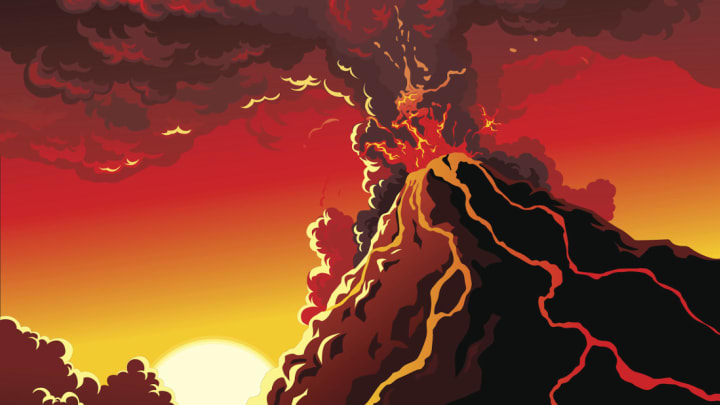Escaping from an erupting volcano is one of those things you find yourself doing a lot less frequently as an adult than you might have imagined as a child. Still, you never know.
To better equip yourself for that possible situation, we spoke with Dr. Janine Krippner—a volcanologist and outreach specialist with the Smithsonian Global Volcanism Program, who is currently based at New Zealand's Mount Ngauruhoe, best known as Mount Doom in The Lord of the Rings movies—about the dos and don'ts of surviving a volcanic eruption.
1. Sometimes, doing nothing is the best plan.
“We live on a very volcanically active planet,” Krippner tells Mental Floss. “At any given point, there are 40 to 50 volcanoes going through ongoing eruption phases. Hundreds of millions of people live on potentially active volcanoes. Some people live on erupting volcanoes all the time.” However, a lot of volcanoes are monitored—among the tools scientists use are observatories, seismic stations, GPS measurement of hillsides inflating or deflating, satellites keeping an eye from space, and so on—and most volcanic activity is fairly small-scale. "The smaller the eruption, the more common it is. It’s just a natural part of what the planet is doing," she says. Most of the time you don’t need to do a thing, as there are experts all over the world keeping an eye on volcanic activity and are well positioned to anticipate—and alert you to—anything dodgy approaching on the ol’ magma front.
2. You can't hide always hide from lava—but you can run (or even walk) from it.
“Lava is essentially a hot bulldozer, but most of the time you can out-walk it,” Krippner says. "Occasionally we get eruptions like Mount Nyiragongo in May this year, with very fast lava flows which have led to fatalities. But generally it’s slow enough for people to evacuate.”
The same can't necessarily be said for infrastructure: If you live on or near an erupting volcano, a lava flow could take out your house. And lava remains hot for a very long time; if it ends up lying in thick deposits, it can still be producing gases at temperatures of hundreds of degrees years later. Usually “there goes the neighborhood” is a metaphor, but in the aftermath of a volcanic eruption, you can actually see it go.
3. If you see an ash cloud, get inside and close your windows.
“Volcanic ash can go much farther than lava," Krippner says. "The Eyjafjallajökull eruptions in Iceland in 2010 grounded air traffic for, what, weeks, months? And that eruption wasn't that big. Large eruptions that produce a lot of ash can destroy structures nearby, because the stuff is really heavy and corrosive. But unless you’re very close—where the densest ash falls—or have asthmatic conditions or your house is at risk of collapsing, your best bet is probably to stay inside with the windows closed.”
If you're particularly unlucky, the volcano in question might produce a pyroclastic flow, an incredibly fast-moving mixture of gas and volcanic fragments that can reach thousand-degree temperatures. This is what happened at Pompeii, so it’s a good news, bad news situation: The good news is you might end up as a tourist attraction. The bad news is extremely bad. (In 2018, scientists determined that several people died when pyroclastic flows from Mt. Vesuvius vaporized their body fluids.)
4. Know that the eruption is only one part of the problem.
Lava and ash get all the press, but there are other ways volcanoes can hurt you. “Ballistics are rocks thrown up out of the volcano which can end up traveling kilometers before crashing down, incredibly hot, and potentially starting fires,” Krippner explains. “Then there are lahars, volcanic mudflows, which are caused when an eruption breaks the sides of a crater lake, bursts a dam, or melts glacier ice. These can travel extremely quickly, picking up more and more material, and are incredibly dangerous.” In 1985, Colombia's Nevado del Ruiz erupted, and while the eruption itself was fairly small, it melted a lot of snow and ice, creating a lahar that tragically wiped out a whole town. If a lahar is coming and you live in a valley, you need to evacuate immediately.
5. Do whatever the experts tell you.
Volcanologists across the world work together and are constantly sharing information and developments with one another. But however advanced science gets in terms of forecasting volcanic events, there will always be plenty of ways for eruptions to come out of the blue. “We have an active geothermal system and it may just go when the pressure gets too much,” Krippner says. “Mount Ontake in Japan erupted in 2014 with no warning, killing hikers.” If something does occur with no prior warning, your best bet is likely to be following the advice of those in the know: “Volcano observatories and local emergency management should be your first ports of call in terms of figuring out what to do.”
